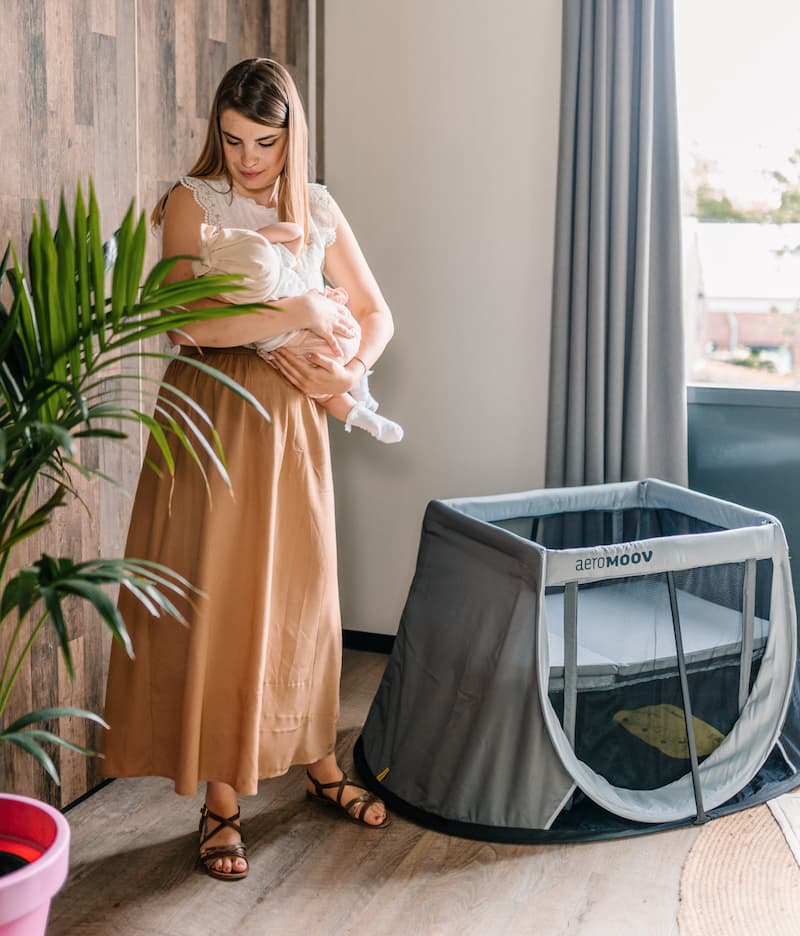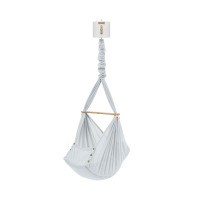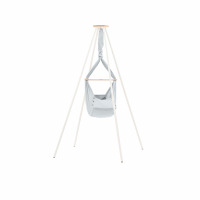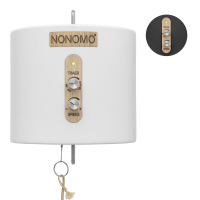As new parents, ensuring your baby gets enough quality sleep is crucial for their healthy development and your sanity. Creating a consistent sleep routine and schedule is key to fostering better sleep habits for your little one. In this article, we'll explore the importance of sleep routines and schedules for babies from birth until the age of 2, with a special focus on the advantage of using baby hammocks to aid daytime sleep and tackling developmental sleep regression moments. Additionally, we'll address the notorious 4-month sleep regression and offer tips to navigate this challenging phase.


Why sleep matters
Sleep is the foundation of a child's growth and development. During sleep, babies' brains process and consolidate new information, and their bodies grow and rejuvenate. Proper sleep patterns also contribute to improved mood, reduced irritability, and enhanced cognitive abilities. As parents, your primary goal is to create an environment that promotes healthy sleep habits.
Daytime sleep is just as crucial as nighttime sleep for a baby's overall well-being and development. Naps during the day help babies process information, rest their bodies, and prevent overtiredness, which can lead to nighttime sleep disturbances. Creating a conducive environment and following a consistent daytime sleep routine can greatly improve your baby's daytime napping habits.
Tips for helping your baby nap during the day
-
Establish a daytime sleep routine
Just like a bedtime routine, a daytime sleep routine can signal to your baby that it's naptime. Keep the routine calming and consistent. For example, you could dim the lights, use white noise or soft lullabies, and engage in a short, soothing activity before laying your baby down for their nap.
-
Create a peaceful sleep environment
Designate a quiet and comfortable space for your baby's daytime naps. Consider using blackout curtains to minimize distractions and maintain a cool, soothing room temperature.
-
Use NONOMO® Hammocks for daytime naps
NONOMO® hammocks provide an excellent solution for daytime naps. The gentle rocking motion of the hammock mimics the comforting sensation of being held, helping your new baby relax and fall asleep faster. Its ergonomic design promotes a safe and natural sleep posture, reducing the risk of flat head syndrome.
-
Pay attention to sleep cues
Learn to recognize your baby's sleep cues, such as rubbing their eyes, yawning, or becoming fussy. When you notice these signs, it's a good indication that your baby is ready for a nap. Respond promptly to avoid overtiredness, which can make it more challenging for them to fall asleep.
-
Follow appropriate awake windows
Age-appropriate awake windows vary based on your baby's age. Newborns can typically stay awake for only 45 minutes to an hour before needing to nap, while older babies may tolerate longer awake periods. Sticking to these windows can help your baby nap more easily.
-
Swaddling or sleeping bags
Swaddling can provide a sense of security and prevent the startle reflex from waking your baby during naps. As they grow older, consider using sleeping bags, which keep them cozy without the need for full swaddling.
-
Be flexible
How many hours sleep does your baby need? While establishing a routine is essential, be flexible with daytime naps as well as the recommended hours sleep, as each baby has different sleep needs. Not all naps will be perfect, and that's okay. If your baby misses a nap or has a shorter nap, try to adjust their schedule accordingly to avoid overtiredness
-
Offer comfort and reassurance
If your baby is having trouble settling for a nap, offer them comfort and reassurance. Gentle rocking, patting, or soft humming may help soothe them to sleep.


Baby sleep schedules for different age groups
Sleep schedule 1-month-old:
The first few weeks, your newborn babies' sleep patterns are still unpredictable, with short sleep cycles and frequent night waking. They have not yet found their circadian rhythm. To establish a gentle newborn sleep routine, try dimming the lights, speaking softly, and swaddling your newborn baby before bedtime. Use the NONOMO® hammock during the day to provide a soothing environment for daytime naps. The hammock's gentle rocking motion and cocoon-like feeling will help your little one feel secure and encourage longer periods of sleep.
Sleep schedule 2-month-old:
As your baby reaches two months, your baby's sleep patterns might be starting to show some consistency, as your baby learns the difference between day and night. Most babies don't sleep through the night yet, as they need night feeding. Create a bedtime routine that includes a warm bath, a calming massage, and gentle lullabies. During the day, continue using the NONOMO® hammock to facilitate daytime naps. The hammock's ergonomic design supports your baby's natural sleep posture, making it easier for them to start sleeping and it helps them in staying asleep longer.
Sleep schedule 3-month-old:
At three months of age, your baby might be sleeping for longer stretches at night and will start to have longer wake windows. Encourage this baby's sleep schedule by maintaining a regular infant sleep schedule and a peaceful sleep environment.
Sleep schedule 6-month-old:
At six months, your baby's sleeping habits should be more predictable, and you might feel like it is a sleep success. They might be ready for a more structured baby's sleep schedule with two or three naps during the day and a lot more awake time. Use the NONOMO® Hammock for daytime naps to maintain a familiar and restful sleep environment for your growing baby.
Sleep schedule 12- to 18-month-old:
As your baby becomes a toddler, they might transition from two naps to one afternoon nap, which often will be long naps. Stick to a consistent sleep schedule and create a relaxing bedtime routine to help them wind down. The NONOMO® Hammock can still be used for daytime naps or even for relaxing and playing, offering a sense of comfort and security.
Dealing with developmental sleep regression


As your baby grows, they may go through developmental milestones like teething, learning to crawl, or separation anxiety, which can lead to baby sleep regressions. During these times, they are not sleeping as they were previously sleeping, but maintaining consistency is crucial. Offer extra comfort, be patient, and avoid introducing new baby sleep habits that may become sleep associations. The rocking motion of the NONOMO® Hammock can be particularly useful during these periods of sleep regression, providing a reassuring and familiar sensation that helps your baby settle down more easily.
Sleep regression is a challenging phase that can occur at any time during a baby's early years. While its unpredictability can leave parents feeling helpless, some periods are more susceptible to sleep regression due to specific growth spurts and developmental milestones. And remember, this too will pass, and you will feel like sleep success is achieved again.
What age are sleep regressions?
Let's explore when most sleep regressions occur and learn how to manage sleep disruption with grace and patience.
Around the 4-month mark, many babies experience a sleep regression, which can be challenging for both baby and parents. This is also called the 12-week sleep regression. During this phase, your baby's sleep pattern become more adult-like, and they may experience frequent night wakings and difficulty settling back to sleep. At this age, several factors contribute to baby sleep problems. Teething can cause pain and discomfort, while growth spurts lead to increased hunger. Additionally, the excitement of rolling over for the first time can affect sleep routines.
To cope with the 4-month sleep regression, continue following your established bedtime routine and use the NONOMO® Hammock to provide comfort and reassurance during daytime and nighttime naps. Remember that this regression is a temporary phase and consistency is the key to overcoming it successfully.
Around 6 months old, many babies go through another growth spurt. However, by this age, they are more capable of sleeping through the night and might wake up seeking comfort and reassurance through snuggles. This could be an ideal time to try out sleep training methods to establish better sleep habits.
As babies approach 9 months, they often start crawling and standing at around 10 months. Separation anxiety is also common at this stage, leading to trouble falling asleep, as well as nighttime awakenings as they seek reassurance from caregivers.
Between 9 to 12 months, babies start standing up, and some may take their first steps. These significant milestones can temporarily disrupt sleep patterns as they adjust to newfound physical abilities.
Toddlers experience sleep issues at various stages, typically around 15 months, 18 months, 2 years, and 3 years old. These regressions can be triggered by nightmares, night terrors, fear of the dark, teething, and separation anxiety. Child sleep can be challenging at various times, so remember that many children just seek reassurance and comfort.
Tips for managing sleep regression
The good news is that sleep regressions are usually temporary. Here are some tips to help you manage sleep issues with your baby and get them on track sooner:
Sufficent daytime sleep:
Ensure your baby gets enough daytime sleep to prevent overtiredness, which can lead to nighttime sleep problems. A good baby sleep schedule can help.
Gentle response:
If your baby wakes up crying at night, give them a few minutes to self-soothe before responding, so let your baby fall asleep by himself. Offer quiet reassurance and avoid creating new sleep associations, like rocking or feeding.
Sleep training:
Consider sleep training if your baby is at least 4 to 6 months old. Give the process a couple of weeks to determine its effectiveness.
Extra attention:
Provide extra attention and comfort during the day, especially before bedtime, to ease any stress or separation anxiety your baby might be experiencing and help your baby relax.
Can sleep regression be prevented?
Unfortunately, sleep regression is a natural part of a baby's development and cannot be entirely prevented. However, maintaining a consistent bedtime routine and sleep schedule can reduce the likelihood of sleep problems.


Creating a healthy sleep routine and schedule for your baby is vital for their growth and well-being during their first two years of life. NONOMO® hammocks are a valuable tool for promoting restful daytime sleep, thanks to their soothing rocking motion and womb-like design. Each baby is unique, and it's essential to remain patient and adaptable as you navigate through various developmental phases, including the 4-month sleep regression. Remember that sleep regression is a normal part of your baby's growth, and with patience, love, and the right sleep environment, you can navigate these moments smoothly. As parents, prioritize healthy sleep habits, and watch your little one grow into a happy and well-rested toddler.



